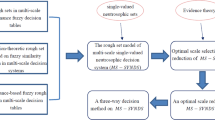Abstract
Motivated by the ideas of interval neutrosophic linguistic sets and hesitant fuzzy sets (HFSs), this paper proposes the concept of hesitant interval neutrosophic linguistic sets by combining the three concepts of the HFS, interval neutrosophic set, and linguistic set and defines the operational laws of hesitant interval neutrosophic linguistic elements (HINLEs) and the score, accuracy, and certainty functions for HINLEs. Then, a hesitant interval neutrosophic linguistic weighted average (HINLWA) operator and a hesitant interval neutrosophic linguistic weighted geometric (HINLWG) operator are developed to aggregate the hesitant interval neutrosophic linguistic information. Moreover, some desirable properties of the two operators are investigated. A decision-making method based on the HINLWA and HINLWG operators is developed to handle multiple attribute decision-making problems, in which evaluation values of each alternative with respect to attributes are expressed by the form of HINLEs, under hesitant interval neutrosophic linguistic environment. Finally, an illustrative example about investment alternatives is given to demonstrate the application of the developed method.


Similar content being viewed by others
References
Broumi S, Ye J, Smarandache F (2015) An extended TOPSIS method for multiple attribute decision making based on interval neutrosophic uncertain linguistic variables. Neutrosophic Sets Syst 8:25–34
Chi PP, Liu PD (2013) An extended TOPSIS method for the multiple attribute decision making problems based on interval neutrosophic sets. Neutrosophic Sets Syst 1:63–70
Herrera F, Herrera-Viedma E, Verdegay JL (1996) A model of consensus in group decision making under linguistic assessments. Fuzzy Sets Syst 79(1):73–87
Herrera F, Herrera-Viedma E (2000) Linguistic decision analysis: steps for solving decision problems under linguistic information. Fuzzy Sets Syst 115(1):67–82
He YD, He Z, Wang GD, Chen HY (2015) Hesitant fuzzy power Bonferroni means and their application to multiple attribute decision making. IEEE Trans Fuzzy Syst 23:1655–1668
He YD, He Z, Chen HY (2015) Intuitionistic fuzzy interaction Bonferroni means and its application to multiple attribute decision making. IEEE Trans Cybern 45:116–128
He YD, He Z (2016) Extensions of Atanassov’s intuitionistic fuzzy interaction Bonferroni means and their application to multiple attribute decision making. IEEE Trans Fuzzy Syst. https://doi.org/10.1109/TFUZZ.2015.2460750
He Y, Wang X, Huang JZ (2016) Recent advances in multiple criteria decision making techniques. Int J Mach Learn Cybern. https://doi.org/10.1007/s13042-015-0490-y
Liang X, Wei C, Chen Z (2013) An intuitionistic fuzzy weighted OWA operator and its application. Int J Mach Learn Cybern 4(6):713–719
Liu PD, Chu YC, Li YW, Chen YB (2014) Some generalized neutrosophic number Hamacher aggregation operators and their application to group decision making. Int J Fuzzy Syst 16(2):242–255
Liu PD, Wang YM (2014) Multiple attribute decision-making method based on single-valued neutrosophic normalized weighted Bonferroni mean. Neural Comput Appl 25(7–8):2001–2010
Smarandache F (1999) A unifying field in logics. Neutrosophy: neutrosophic probability, set and logic. American Research Press, Rehoboth
Torra V, Narukawa Y (2009) On hesitant fuzzy sets and decision. In: The 18th IEEE international conference on fuzzy systems. Jeju Island, Korea, pp. 1378–1382
Torra V (2010) Hesitant fuzzy sets. Int J Intell Syst 25:529–539
Wang H, Smarandache F, Zhang YQ, Sunderraman R (2005) Interval neutrosophic sets and logic: theory and applications in computing. Hexis, Phoenix
Wang H, Smarandache F, Zhang YQ, Sunderraman R (2010) Single valued neutrosophic sets. Multispace Multistruct 4:410–413
Xia MM, Xu ZS (2011) Hesitant fuzzy information aggregation in decision making. Int J Approx Reason 52:395–407
Ye J (2013) Multicriteria decision-making method using the correlation coefficient under single-valued neutrosophic environment. Int J Gen Syst 42(4):386–394
Ye J (2014) Single valued neutrosophic cross-entropy for multicriteria decision making problems. Appl Math Model 38:1170–1175
Ye J (2014) Similarity measures between interval neutrosophic sets and their applications in multicriteria decision-making. J Intell Fuzzy Syst 26:165–172
Ye J (2014) Some aggregation operators of interval neutrosophic linguistic numbers for multiple attribute decision making. J Intell Fuzzy Syst 27:2231–2241
Ye J (2015) An extended TOPSIS method for multiple attribute group decision making based on single valued neutrosophic linguistic numbers. J Intell Fuzzy Syst 28:247–255
Ye J (2015) Multiple-attribute decision-making method under a single-valued neutrosophic hesitant fuzzy environment. J Intell Syst 24(1):23–36
Ye J (2017) Multiple attribute group decision making based on interval neutrosophic uncertain linguistic variables. Int J Mach Learn Cybern 8(3):837–848
Zadeh LA (1975) The concept of a linguistic variable and its application to approximate reasoning Part I. Inf Sci 8(3):199–249
Zhang HY, Wang JQ, Chen XH (2014) Interval neutrosophic sets and their application in multicriteria decision making problems. Sci World J 2014:645953. https://doi.org/10.1155/2014/645953
Acknowledgements
This paper was supported by the National Natural Science Foundation of China (no. 71471172).
Author information
Authors and Affiliations
Corresponding author
Rights and permissions
About this article
Cite this article
Ye, J. Hesitant interval neutrosophic linguistic set and its application in multiple attribute decision making. Int. J. Mach. Learn. & Cyber. 10, 667–678 (2019). https://doi.org/10.1007/s13042-017-0747-8
Received:
Accepted:
Published:
Issue Date:
DOI: https://doi.org/10.1007/s13042-017-0747-8




